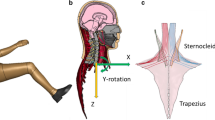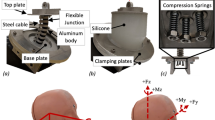Abstract
Impact situations, usually involving high-G accelerations, typically take less than 40 ms to occur. In such scenarios human subjects behave in a passive-like manner as muscle activation does not have time to intervene. However, there are other situations also prone to injury that involve perilous nonimpact scenarios where predominant low-G accelerations are sustained during long periods of time, leading any alert subject to exhibit a muscular reaction to the ongoing events. Actual Anthropometric Test Devices (ATDs) exhibit passive muscular behaviour and are therefore specially tailored for the first scenarios, although their use in low-G applications has been reported in the literature. In this work a validated computational multibody model of an ATD is integrated inside a generic and simplified vehicle interior. Three-dimensional trajectories, describing extreme driving conditions, are taken from a driving simulator and feed into a multibody simulator package in order to observe if the ATD accurately reproduce the expected human behaviour. A feedback-controlled version of this ATD is then devised and its head–neck complex (HNC) response compared with the passive one and with real data acquired with a volunteer. The results obtained are discussed, and conclusions and future trends are provided.
Similar content being viewed by others
References
Oakley, C.: Roadmap of future automotive passive safety technology development. Technical report, APSN—European Vehicle Passive Safety Network (2004)
Silva, M., Ambrósio, J.: Sensitivity analysis on the occupant injury biomechanics with respect to the seating position. In: Proceedings of ICRASH-2004 Conference, San Francisco, California, 14–16 July 2004
Minoyama, O., Tsuchida, H.: Injuries in professional motor car racing drivers at a racing circuit between 1996 and 2000. Br. J. Sports Medicine 38, 613–616 (2004)
Gugler, J., Steffan, H.: Improvement of rollover safety for passenger vehicles. ROLLOVER Project—Final public report, EC 5th Framework Program (2006)
van der Horst, M. et al.: The influence of muscle activity on head–neck response during impact. In: Proceedings of the 41st Stapp Car Crash Conference Society of Automotive Engineers (1997)
B.-Fornari, J., Arabyan, A., Deng, Y.-C.: Use of active muscles in a model of the human head and neck. In: Proceedings of the 42nd Stapp Car Crash Conference Society of Automotive Engineers (1998)
van Lopik, D.W., Acar, M.: A computational model of the human head and neck system for the analysis of whiplash motion. Int. J. Crashworthiness 9(5), 465–473 (2004)
Stemper, B., Yoganandan, N., Pintar, F.: Occupant awareness affects whiplash biomechanics. J. Biomech. 39(S1), S147 (2006)
Kumar, S., Narayan, Y., Amell, T.: An electromyographic study of low-velocity rear-end impacts. Spine 27(10), 1044–1055 (2002)
Ambrósio, J., Silva, M.T.: A biomechanical multibody model with a detailed locomotion muscle apparatus. In: Ambrósio, J. (ed.) Advances in Computational Multibody Systems, pp. 155–184. Springer, Dordrecht (2005)
Silva, M.: Multi-body based computer tools for analysis of the biomechanics of musculoskeletal systems. J. Biomech. 39(S1), S421 (2006)
Silva, M.: Human motion analysis using multibody dynamics and optimisation tools. Ph.D. thesis, Dept. of Mechanical Engineering, IST, TU Lisbon (2003)
Ambrósio, J., Silva, M.T.: Methodologies for forward and inverse dynamic analysis of the biomechanics of the human motion. In: González, Y., Cerrolaza, M. (eds.) Bioengineering Modelling and Computer Simulation. CIMNE, Barcelona (2007)
Nikravesh, P.: Computer Aided Analysis of Mechanical Systems. Prentice-Hall, Englewood Cliffs (1988)
Haug, E.: Computer Aided Kinematics and Dynamics of Mechanical Systems. Allyn & Bacon, Newton (1989)
TNO MADYMO BV: MADYMO Model manual version 6.2. TNO, Netherlands (2004)
Ambrósio, J., Silva, M.T.: Multibody Dynamics Approaches for Biomechanical Modelling in Human Impact Applications. In: IUTAM Proceedings on Impact Biomechanics: From Fundamental Insights to Applications, pp. 61–80. Springer, Dordrecht (2005)
Silva, M., Ambrósio, J., Pereira, M.: Biomechanical model with joint resistance for impact simulation. Multibody Syst. Dyn. 1(1), 65–84 (1997)
Silva, M., Ambrósio, J.: Pedestrian impact and run over using a multibody simulation tool. Int. J. Crashworthiness 4(3), 261–271 (1999)
Ogata, K.: Modern Control Engineering, 3rd edn. Prentice-Hall, Englewood Cliffs (1997)
Franklin, G.F., Powell, J.D., Naeini, A.E.: Feedback Control of Dynamic Systems, 3rd edn. Addison-Wesley, Reading (1994)
Tortora, G., Grabowski, S.R.: Introduction to the Human Body. Wiley, New York (2001)
Seeley, R., Stephens, T., Tate, P.: Anatomy and Physiology. McGraw-Hill, New York (2006)
Kandel, E., Schwartz, J., Jessel, T.: Principles of Neural Science. McGraw-Hill, New York (1991)
Roberts, S., Bailey, E., van Vlaardingen, V.: LFS Manual. Web address: http://en.lfsmanual.net/wiki/Main_Page (last updated November 2008)
Almeida, J., Fraga, F., Silva-Carvalho, L., Silva, M.T.: Dynamic simulation of non-impact scenarios using a multibody biomechanical model. Technical report IDMEC/CPM/2007/002, Instituto Superior Técnico, TULisbon (2007)
Fraga, F., Almeida, J., Silva-Carvalho, L., Silva, M.T.: A Feedback-controlled system for the dynamic simulation of an ATD’s head–neck complex in non-impact scenarios. Technical report IDMEC/CPM/2007/003, Instituto Superior Técnico, TULisbon (2007)
International Research Council on the Biomechanics of Impact (IRCOBI): Future research directions in injury biomechanics and passive safety research. Technical report, International Research Council on the Biomechanics of Impact, Bron, France (2006)
Author information
Authors and Affiliations
Corresponding author
Rights and permissions
About this article
Cite this article
Almeida, J., Fraga, F., Silva, M. et al. Feedback control of the head–neck complex for nonimpact scenarios using multibody dynamics. Multibody Syst Dyn 21, 395–416 (2009). https://doi.org/10.1007/s11044-009-9148-4
Received:
Accepted:
Published:
Issue Date:
DOI: https://doi.org/10.1007/s11044-009-9148-4




